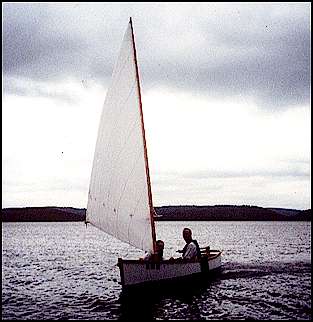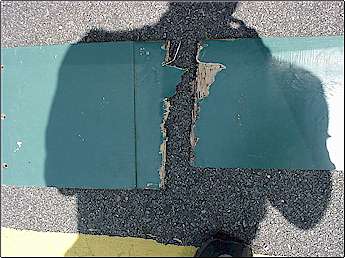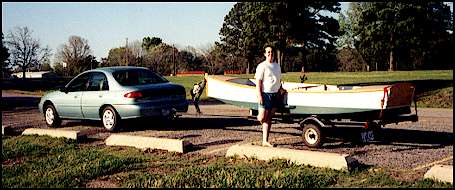| I have been sailing several times
recently - went out with my son and daughter, Kevin and Mary, about a week ago. It
was Kevin's first time out. The three of us sailed around for awhile - it was quite
a load to move around. I let him handle the tiller and mainsheet for most of the
time and we talked sail trim and how to adjust the sail for the boat's heading - I sat on
the center seat, Kevin the aftermost seat and Mary sat in the little space forward of the
partner. After a while Mary wanted to be dropped off in the lake's swimming area, so
Kevin sailed us over there, Mary pushed off from a sitting position from the mast partner,
and then Kevin and I sailed back to put the boat on the trailer.  But the wind died completely before we got back to the ramp. So for the
first time I had to unship the oars while underway with sail set and row back about a ¼
mile from the swimming area over to the launch ramp (my oars are stowed on centerline
under a center removable seat). Kevin attempted rowing first, but did not get the
hang of it at all, and was not in a mood to learn another skill, especially after the
sailing part came so easily to him - so I rowed us back. It rowed well. Kevin
was really pleased with it all. But the wind died completely before we got back to the ramp. So for the
first time I had to unship the oars while underway with sail set and row back about a ¼
mile from the swimming area over to the launch ramp (my oars are stowed on centerline
under a center removable seat). Kevin attempted rowing first, but did not get the
hang of it at all, and was not in a mood to learn another skill, especially after the
sailing part came so easily to him - so I rowed us back. It rowed well. Kevin
was really pleased with it all.
Last night I had a little bit more of an adventure
though. I picked up a young friend, 8 year old Ben Lykins (his 2nd jaunt).
However, because of a strong north wind blowing right against the boat ramp, I had to pole
the boat over to the dock using the sprit boom as the pole (that worked well) and tied her
up to rig her.
The waves were fairly high and the gunwale kept
dropping below the level of the dock and wanted to come up under the dock. With an
admonition to Ben to keep his hand out from between the dock and boat, he dutifully held
onto a dock cleat, kept us away from the dock despite the waves, while I rigged the sail.
I rigged the sail, lowered the daggerboard and
rudder, and pushed us out. Once we got the boat clear of the dock, I could relax
about Ben losing a finger. The boat handled wonderfully as we left the dock hard on
the wind (45° to the wind). We tacked again and headed out into open water - wind
was about 15 mph and waves about 1 to 1½ foot high - sail not reefed.
 We went along pretty well for about ½ mile - about the center of the lake I
heard some cracking sounds coming from the direction of the daggerboard - and then some
more cracking - and then it stopped and all seemed well. We were on the starboard
tack heading northwest (daggerboard on the low side) so in a bit of a lull I headed up and
quickly leaned over and checked to see if we had hit a log, or were dragging something
that could have made the noise - felt down the front edge of the board as far as I could
reach underwater. All seemed well. We went along pretty well for about ½ mile - about the center of the lake I
heard some cracking sounds coming from the direction of the daggerboard - and then some
more cracking - and then it stopped and all seemed well. We were on the starboard
tack heading northwest (daggerboard on the low side) so in a bit of a lull I headed up and
quickly leaned over and checked to see if we had hit a log, or were dragging something
that could have made the noise - felt down the front edge of the board as far as I could
reach underwater. All seemed well.
We reached the far side. Ben said he wanted to go to the
train tracks at the north end of the lake, so we tacked into the wind and headed now off
to the northeast - and that's when it gave out. The daggerboard gave one last brief
crack and split right at the lower brace. It stuck out to windward like a killdeer's
broken wing. I reached out grabbed it before it completely splintered off and
brought it aboard - the top of the board still secured nicely in place.
Ben said, "This does not look like a good sign." But I reassured him and
said that we were going to be fine. He offered to hold the board on the side of the
boat for me!
 Well we were pretty much windward, but across the lake from the ramp and there
was nothing to do but try and broad reach back to the dock. My fear was getting
blown too far off course and ending up on the Dardanelle side - or worse: losing control
and capsizing a ½ mile out. Well we were pretty much windward, but across the lake from the ramp and there
was nothing to do but try and broad reach back to the dock. My fear was getting
blown too far off course and ending up on the Dardanelle side - or worse: losing control
and capsizing a ½ mile out.
Without the board on a broad reach the boat really took off - a
very fast sail, sometimes getting up on a bit of a plane. We did not make too much
leeway at all (90 degrees chines and 3 bottom skids help), but we lost all the roll
dampening the board provides, and lost a lot of steering control - the boat wanted to
round downwind in the gusts and I had to really fight it from running away. Roll
dampening was a stress that I had not really taken into consideration.

Now we experienced what the board did for us, and were shown
that on a day with short steep waves the board was exposed to much more bending stress -
in other words, we rolled quite a bit, several times a wave was right at the gunwale.
With the wind on our aft port quarter we drove straight into the ramp - I knew I
would not be able to turn it back towards the dock with no board. When I was about
one boat length from the waves breaking on the ramp, and I felt the rudder start to kick
up, I put the tiller hard over and jumped out into knee-deep water. We loaded up the
boat. |
The New Leeboard
The "Superply", which is the predominant
ply in the boat, is made with thin outer veneers and a thicker inner veneer. The
board is made of 2 layers of it with the yellow South American hardwood veneer on the
outside, the thin luan veneers in the center (Doug fir cores). Under a bending
stress, the outer veneer on the outside of the bend, feels virtually all the tensile
stress - the inside of the bend feels compressive stress. The next veneer layer,
which is twice as thick as the outer veneer, of course provides no strength to bending
stress. There was also bad grain patterns on the outer veneer right at the lower
daggerboard brace. I had overlooked this during construction.
My fix will be to use ¼ inch southern yellow pine
ply which has thick outer veneers - each veneer is equally 1/3 of the thickness.
Yellow pine is also a strong species of wood.
(see picture at
bottom of page)
I will carefully check it for bad grain and will
avoid any factory patches (Dutchmen). I am also considering running a piece of glass
tape lengthwise on both sides of the board - it has tremendous tensile strength.
Here is some info about the new leeboard. The replacement ply was sold as
1/4" but was really 5/16" with thicker outer veneers. I made test samples
of old and new that were 1" wide and 20" long. They were tested to failure
with a spring scale. The new yellow pine was ~50% stronger based on the tests.
The new board profile is curved on the leading and trailing edge, with a
tightening radius as it reaches the end. The trailing edge is worked down so that it
tapers over 3" to a 1/16" square edge. The leading edge is rounded and
smoothly rounds back from the leading edge about 1 1/4". This is what I have
put together from my reading as a good compromise between lift and drag on a wooden board.
The board definitely develops more lift than the original. It is coated with
epoxy and latex paint, but with no primer. |